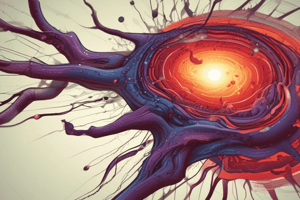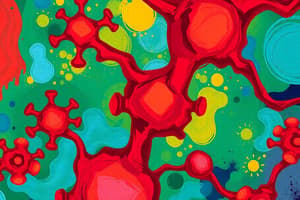Podcast
Questions and Answers
How does aspirin's mechanism of action reduce platelet aggregation?
How does aspirin's mechanism of action reduce platelet aggregation?
- By increasing prostacyclin production.
- By blocking cyclooxygenase (COX) enzymes reversibly.
- By promoting prostacyclin synthesis and inhibiting thromboxane A2.
- By inhibiting thromboxane A2 synthesis. (correct)
Which of the following is a common side effect associated with chronic use of glucocorticosteroids?
Which of the following is a common side effect associated with chronic use of glucocorticosteroids?
- Increased muscle mass.
- Hypoglycemia
- Enhanced wound healing.
- Immune suppression (correct)
A patient with a history of peptic ulcers is prescribed an NSAID for pain management. Which type of NSAID would be most appropriate for this patient, considering their medical history?
A patient with a history of peptic ulcers is prescribed an NSAID for pain management. Which type of NSAID would be most appropriate for this patient, considering their medical history?
- A traditional NSAID administered intravenously.
- A non-selective NSAID like ibuprofen.
- A high dose of aspirin.
- A COX-2 selective NSAID like celecoxib. (correct)
What is the primary mechanism of action of uricosuric drugs like probenecid in the treatment of gout?
What is the primary mechanism of action of uricosuric drugs like probenecid in the treatment of gout?
Which of the following is the most accurate description of how disease-modifying antirheumatic drugs (DMARDs) work?
Which of the following is the most accurate description of how disease-modifying antirheumatic drugs (DMARDs) work?
Which of the following best describes the role of prostaglandins in the body?
Which of the following best describes the role of prostaglandins in the body?
What is the primary target of triptans in the treatment of migraine?
What is the primary target of triptans in the treatment of migraine?
In a patient presenting with an aspirin overdose, which of the following is a critical step in the initial management?
In a patient presenting with an aspirin overdose, which of the following is a critical step in the initial management?
What is the most likely mechanism of action of paracetamol?
What is the most likely mechanism of action of paracetamol?
A patient is prescribed an opioid analgesic for severe pain following surgery. What common side effect should the patient be educated about?
A patient is prescribed an opioid analgesic for severe pain following surgery. What common side effect should the patient be educated about?
In the arachidonic acid pathway, what is the role of phospholipase A2?
In the arachidonic acid pathway, what is the role of phospholipase A2?
Which of the following non-selective NSAIDs has some relative selectivity for COX-2 inhibition?
Which of the following non-selective NSAIDs has some relative selectivity for COX-2 inhibition?
A patient with a history of cardiovascular disease is considering taking an NSAID for chronic pain. Which NSAID should be used with caution due to an increased risk of cardiovascular thrombotic events?
A patient with a history of cardiovascular disease is considering taking an NSAID for chronic pain. Which NSAID should be used with caution due to an increased risk of cardiovascular thrombotic events?
What is the rationale behind administering activated charcoal in the treatment of paracetamol overdose?
What is the rationale behind administering activated charcoal in the treatment of paracetamol overdose?
Which of the following is the primary advantage of using rectal or parenteral administration of NSAIDs following surgery?
Which of the following is the primary advantage of using rectal or parenteral administration of NSAIDs following surgery?
Flashcards
What is the inflammatory cascade?
What is the inflammatory cascade?
Pain, inflammation, and fever involve a complex cascade of events in the body.
Effects of prostaglandins?
Effects of prostaglandins?
Prostaglandins cause vasodilation, pain, and fever.
Non-Selective NSAIDs
Non-Selective NSAIDs
Non-Selective NSAIDs block both COX-1 and COX-2 enzymes.
COX-2 Selective NSAIDs
COX-2 Selective NSAIDs
Signup and view all the flashcards
Aspirin's mechanism and benefits?
Aspirin's mechanism and benefits?
Signup and view all the flashcards
Glucocorticosteroids
Glucocorticosteroids
Signup and view all the flashcards
DMARDs
DMARDs
Signup and view all the flashcards
Paracetamol
Paracetamol
Signup and view all the flashcards
Action of Opioids
Action of Opioids
Signup and view all the flashcards
What is gout?
What is gout?
Signup and view all the flashcards
Migraine?
Migraine?
Signup and view all the flashcards
Allopurinol
Allopurinol
Signup and view all the flashcards
Triptans action for migraines?
Triptans action for migraines?
Signup and view all the flashcards
Naloxone
Naloxone
Signup and view all the flashcards
Study Notes
Unit Learning Outcomes: Pain, Inflammation, and Fever
- Describe the effects of prostaglandins on the body
- List and differentiate between the various isoforms of cyclooxygenase
- List the different groups of drugs used in pain, fever, and inflammation with drug examples in each group
- Differentiate between the indications and mechanisms of action for the different groups of drugs
- Explain why aspirin is used to reduce platelet aggregation
- Briefly describe the treatment of migraine
- Briefly describe the treatment of gout (acute and chronic)
Pain, Inflammation, and the Inflammatory Cascade
- NSAIDs and corticosteroids are used in the cascade
- Non-painkillers for specific pain syndromes, e.g., gout, migraine, and neuropathy may be used
- Opioids and paracetamol modulate central perception
The Inflammatory Cascade (Arachidonic Acid Pathway)
- Infection, antibodies, or physical injury can initiate the cascade
- Membrane phospholipids are converted into arachidonic acid by phospholipase C and phospholipase A2
- NSAIDs inhibit the cyclooxygenase (COX) enzymes
- Corticosteroids inhibit phospholipase A2
- Arachidonic acid is converted to prostaglandin H2 by cyclooxygenase (COX 1, 2 & 3)
- Prostaglandin H2 turns into leukotrienes by 5-lipoxygenase
- Leukotrienes are inhibited by LOX-inhibitors
- Leukotriene antagonists reduce the effects of leukotrienes
- Prostaglandin D2 is involved in bronchoconstriction and vasoconstriction and acts opposite PGE2
- Prostaglandin E2 regulates pain, inflammation and various physiological processes
- Prostaglandin F2α causes uterine contraction
- Dinoprostone causes uterine contraction, vasoconstriction and maintains ductus arteriosus
- Prostacyclin (PGI2) causes vasodilation and inhibits platelet activation and regulates CVS homeostasis
- Thromboxane (TXA2) is an eicosanoid that causes vasoconstriction and platelet activation
Non-Selective NSAIDs
- Non-selective NSAIDs block both COX-1 and COX-2 enzymes
- These drugs have gastric side effects that can cause gastric and duodenal ulcers
- Examples of non-selective NSAIDs available orally include:
- Salicylic acid derivatives
- Piroxicam (relative selectivity for COX-2)
- Available as rectal preparations (suppositories):
- Indomethacin
- Naproxen
- Mefenamic acid
- Diclofenac (relative selectivity for COX-2)
- Available as injections for IM or IV:
- Ketorolac
- Ibuprofen
- Diclofenac
- Lornoxicam
Selective NSAIDs
- Blocks COX-2 selectively; much less gastric SEs
- Preferred in patients with risk factors for peptic ulcers
- Higher risk of cardiovascular thrombotic events if used chronically
- Available in South Africa:
- Celecoxib (oral)
- Etoricoxib (oral)
- Parecoxib (IV)
- Meloxicam (preferential; IM and oral)
Salicylic Acid Derivatives - Aspirin
- Aspirin is only available orally and binds COX irreversibly
- Aspirin is 90% plasma-protein bound, leading to important drug interactions
- Aspirin excretion is hastened by alkalinizing the urine
- Cross-sensitivity for adverse effects with aspirin use below 20% when using COX-2 inhibitors
- Indications include cardioprotection (MI, stroke, angina) at 75-300mg OD
- Antipyretic and analgesic effects are achieved at 300-650mg q6h
- Inflammation treatment requires 1000mg q6h
- Side effects of aspirin include excessive bleeding, GIT pain, and gastric and duodenal ulcers
- Aspirin is contraindicated in young children (Reye's syndrome) and can exacerbate pulmonary inflammation
- Prolonged use of aspirin may increase uric acid levels, triggering gout
- Overdose of aspirin stimulates the CNS directly leading to hyperpnoea
- Overdose symptoms include nausea/vomiting, diarrhea, restlessness, tinnitus, vertigo, hyperpyrexia, hypovolemia, pulmonary edema, dysrhythmias, acute renal failure, seizures, and coma
- No specific antidote exists for aspirin overdose; treatment involves activated charcoal
- Urinary alkalinisation may be beneficial
- Hemodialysis is used in severe poisoning cases
Indications for the use of NSAIDs
- Rectal and parenteral administration is often used after a C-section, vaginal delivery, or pelvic/other surgery to reduce gastric effects and first-pass metabolism
- Administered IM or IV in hospital for post-surgical pain or other inflammatory pain
- Oral administration is common for muscle injuries, traumatic injuries, joint pain, inflammatory conditions, gout, fever, arthritis, and dysmenorrhoea
- Indomethacin is used in premature infants to promote closure of the ductus arteriosus
The Glucocorticosteroids
- Side effects (mostly due to chronic administration) and include:
- Immune suppression
- HPA-axis suppression
- Osteoporosis
- Cataracts
- Increased IOP
- Ophthalmic infections
- Hyperglycaemia
- Hypertension
- Weight gain
- Abnormal fat distribution
- GIT disturbances
- Growth retardation (paediatric patients)
- Atrophy of the epidermis and dermal collagen (topical)
- Indications:
- Pain and inflammation
- Rheumatic and other inflammatory disorders
- Gout
- Joint and tendon pain (intra-articular administration)
- Allergic, immune and autoimmune disorders
DMARDs
- Disease-Modifying AntiRheumatic Drugs (DMARDs) are used for chronic inflammatory conditions like tendinitis, osteoarthritis and autoimmune disorders.
- DMARDS modify the progression of disease and treat inflammation
- Synthetic drugs
- Sulphasalazine is anti-inflammatory
- Methotrexate acts as an antifolate in cancer chemotherapy
- Biological agents:
- Monoclonal antibodies include infliximab, adalimumab, rituximab, etc.
- Receptor fusion proteins include etanercept and abatacept
Paracetamol
- Paracetamol is widely available, inhibits COX3 in the central nervous system, and has no peripheral inflammatory effects
- Indications are pain and fever, and is the drug of choice for children, infants, and pregnant women
- Side effects are few at therapeutic doses, with hypothermia
- Symptoms include pallor, malaise and sweating.
-
150 mg/kg is considered toxic
- Treatment of overdose:
- Acetylcystein (Parvolex)
- Administer 150 mg/kg in 200 mL 5% dextrose over 1 hour
- Followed by 50 mg/kg in 500 mL 5% dextrose over 4 hours
- Followed by 100 mg/kg in 1L 5% dextrose over 16 hours
- Total dose is 300 mg/kg over 24 hours
- Followed by 150 mg/kg in 1L 5% dextrose over 24 hours
Opioids
- Opioids are used for analgesia, including anaesthesia
- Include opiates drugs derived from opium, including morphine
- They act as agonists on mu, kappa and delta opioid receptors
- Indications include suppression of diarrhoea and cough, and replacement therapy for opioid use disorder
- Side effects include sedation, nausea, respiratory depression, constipation, euphoria, tolerance and physical dependence
- Overdose symptoms include pinpoint pupils, respiratory depression, and a decreased level of consciousness
- Naloxone is a life-saving medication that can reverse an overdose from opioids
- Naloxone is a lipophilic compound that is a non-selective and competitive opioid receptor antagonist
Specific Pain Disorders: Gout
- A familial metabolic disease caused by increased plasma uric acid levels
- Uric acid is an end product of purine metabolism (protein breakdown)
- Uric acid crystals form in joints, causing pain and inflammation
- Gout can be of an acute or chronic nature and usually appears in small joints, e.g. MP joint
- Foods that trigger gout include red meat, alcohol and fructose
- Treatment includes:
- Lifestyle adjustment
- ↓Pain & inflammation: NSAIDs; colchicine; glucocorticoids
- ↑Renal clearance of uric acid: uricosuric drugs (probenecid)
- ↓Conversion of purines to uric acid: xanthine oxidase inhibitors (allopurinol)
Specific Pain Disorders: Migraine
- Migraine is a severe and debilitating headache, often unilateral, feeling like it is behind the eye
- May include vision disturbances, photophobia, nausea, and vomiting
- Often preceded by prodrome and aura
- Treatment includes
- NSAIDs and paracetamol; opioids (analgesics)
- Triptans (5HT1B&D agonists): rizatriptan; sumatriptan; zolmitriptan; naratriptan; eletriptan
- Ergot alkaloids (5HT1&2 agonists): ergotamine
- Preventative: beta-blockers; anti-epileptics; calcium channel blockers; antidepressants
Studying That Suits You
Use AI to generate personalized quizzes and flashcards to suit your learning preferences.




